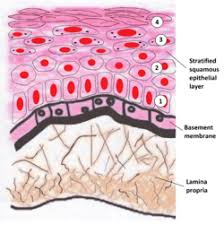 The basement membrane is a thin, sheet-like type of extracellular matrix that provides cell and tissue support and acts as a platform for complex signaling.
The basement membrane is a thin, sheet-like type of extracellular matrix that provides cell and tissue support and acts as a platform for complex signaling.
It sits between epithelial tissues including mesothelium and endothelium, and the underlying connective tissue.
Its primary function is to anchor down the epithelium to its loose connective tissue underneath.
This is achieved by cell-matrix adhesions through substrate adhesion molecules.
Electron microscope findings: the basement membrane is composed of two layers, the basal lamina and the reticular lamina.
The underlying connective tissue attaches to the basal lamina with collagen VII anchoring fibrils and fibrillin microfibrils.
The basal lamina layer can further be subdivided into two layers based on their visual appearance in electron microscopy.
The lighter-colored layer closer to the epithelium is called the lamina lucida.
The denser-colored layer closer to the connective tissue is called the lamina densa.
The electron-dense lamina densa layer is about 30–70 nanometers thick and consists of an underlying network of reticular collagen IV fibrils, and macromolecular components.
The lamina lucida layer is made up of laminin, integrins, entactins, and dystroglycans.
Integrins serve to anchor the epithelium to the underlying basement membrane.
The primary function of the basement membrane is to anchor down the epithelium to its loose connective tissue underneath, and is achieved by cell-matrix substrate adhesion molecules (SAMs).
The basement membrane acts as a mechanical barrier, preventing malignant cells from invading the deeper tissues.
Early stages of malignancy that are thus limited to the epithelial layer by the basement membrane are called carcinoma in situ.
The basement membrane is essential for angiogenesis able accelerate differentiation of endothelial cells.
Basement membrane examples: the glomerular basement membrane of the kidney, formed by the fusion of the basal lamina from the endothelium of glomerular capillaries and the podocyte basal lamina; and between lung alveoli and pulmonary capillaries, by the fusion of the basal lamina of the lung alveoli and of the basal lamina of the lung capillaries, which is where oxygen and CO2 gas exchange occurs.
Other activities for basement membrane include blood filtration and muscle homeostasis.
Poorly functioning basement membrane can be caused by genetic defects, immune disorders, or other mechanisms.
Genetic defects in the collagen fibers of the basement membrane, including Alport syndrome and Knobloch syndrome.
Autoimmune diseases may target basement membranes: Non-collagenous domain basement membrane collagen type IV is autoantigen (target antigen) of autoantibodies in the autoimmune disease Goodpasture’s syndrome; epidermolysis bullosa; systemic lupus erythematosus; dermatomyositis; and possibly lichen sclerosus.
The basement membrane is essential for angiogenesis, being able accelerate differentiation of endothelial cells.
Most recognized basement membranes are the glomerular basement membrane of the kidney, and and between lung alveoli and pulmonary capillarie.
Glomerular BM is created
by the fusion of the basal lamina from the endothelium of glomerular capillaries and the podocyte basal lamina.
The BM between lung alveoli and pulmonary capillaries, is created by the fusion of the basal lamina of the lung alveoli and of the basal lamina of the lung capillaries, which is where oxygen and CO2 diffusion occur.
Roles for basement membrane include blood filtration and muscle homeostasis.
Poorly functioning basement membrane can be caused by genetic defects, orban abnormal immune system, or other mechanisms.
Genetic defects in the collagen fibers of the basement membrane, include Alport syndrome and Knobloch syndrome.
Autoimmune diseases targeting basement membranes: type IV is autoantigen target of autoantibodies in the autoimmune disease Goodpasture’s syndrome.
Diseases associated with improper function of basement membrane zone -epidermolysis bullosa.
A thickened basement membrane indicates systemic lupus erythematosus, dermatomyositis, or possibly lichen sclerosus.
